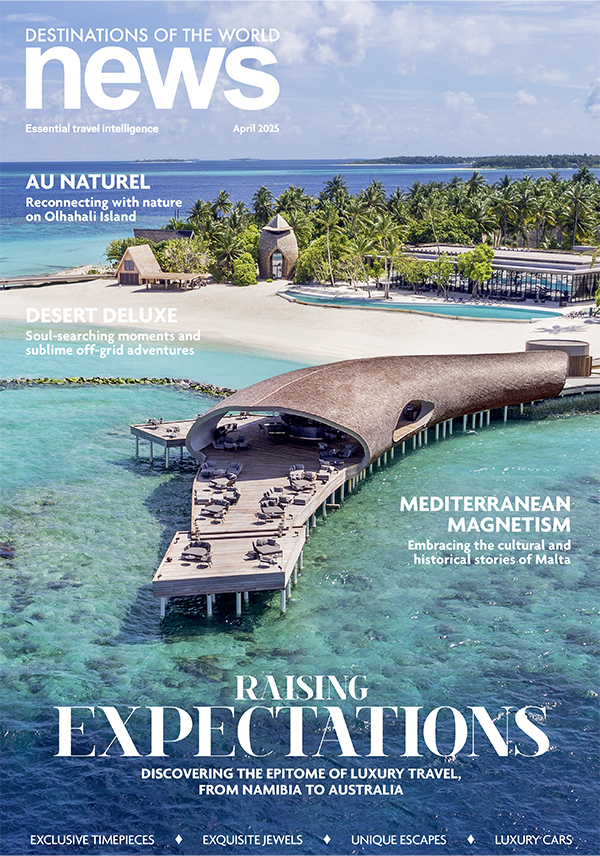 If diamonds are a girl’s best friend, then my new second best friend is jewellery guru David Warren, senior jewellery director at London-based auction house Christie’s – a world-renowned purveyor of fine things. The Glaswegian auction professional has lived a life dedicated to his passion: collecting beautiful objects – and continues to travel the world admiring, valuing and brokering the sale of some of the finest jewellery on the planet.
If diamonds are a girl’s best friend, then my new second best friend is jewellery guru David Warren, senior jewellery director at London-based auction house Christie’s – a world-renowned purveyor of fine things. The Glaswegian auction professional has lived a life dedicated to his passion: collecting beautiful objects – and continues to travel the world admiring, valuing and brokering the sale of some of the finest jewellery on the planet.
“I used to accompany my mother on outings to auction houses and flea markets when I was about 10. She ran a small antiques shop and I would spend all my spare time helping her with reframing, pricing and restoring the pieces she bought. After a while, I decided to start using my own pocket money to buy pieces to sell at auctions and discovered I had a real talent for this,” David recalls at the launch of Christie’s’ Elizabeth Taylor collection in Dubai.
“When I was a Boy Scout, I had to pass my collectors badge, so I put a collection together consisting of arms and armoury. It was brought to my attention that this may be a bit too violent for the Boy Scouts, so I sold it all and collected 18th century drinking glasses instead.”
And so the young teenager from Glasgow got hooked on the thrill of buying and selling, a business he continued into his late teens. Warren’s business was going from strength to strength when his parents insisted he did some- thing a little more formal with his talent.
“I got a job with the biggest auction house in Glasgow, Edmistons, but after a few years I wanted to concentrate on my business. Around the same time a job came up in London with Christie’s in the jewellery department. I didn’t think I would get it but I applied to placate my parents and two weeks later I was in London.”
The move to London gave David the oppor- tunity to not only work for one of the most famous auction houses in the world, but also allowed him enough time to work on his own business too.
“I lived on Portobello Road and did my buying and selling in the market there. Once again though, I got itchy feet and considered leaving – Christie’s offered me the position of associate director of jewellery – it was a brand new position and 27 years later I’m still with the company.”
During his career at Christie’s, Warren has been sent all over the world – an aspect of the job that has clearly left a lasting impression: “They assigned me to the Southeast Asia region and I set up Christie’s jewellery sales in Hong Kong. I made the most of the location and trav- elled around everywhere,” he explains.
“It took me to the ruby mines in Thailand and even the jade auctions in Rangoon in Burma (Myanmar). I was there in 1993 and although I loved the trip, I felt I was being watched. Well, I was being watched. It is a beautiful country though. It’s a place where everyone should visit.
However, as far as travel experiences go, it was a chance find in Colombia that really sticks out in his mind when we discuss his favourite on-the-job memories.
“I flew from Bogota, in a six-seater light- aircraft an hour north to Muzo, the oldest and most famous emerald mine in Colombia. Nor- mally one takes this route in a helicopter, but it broke down so we took the aircraft. The area we were flying into is extremely mountainous and the landing strip is barely long enough for a plane to land safely without falling off the sheer drop that awaits any poor pilot that overshoots.
“We were flying through thick cloud – imagine vanilla ice-cream – through towering mountains when the pilot, a 60-year-old man announced, ‘I haven’t landed on this runway very many times – I’m not used to this!’ I was shaking. We landed, of course, then drove 45 minutes on a road cut out of the cliff, so once again, there was no room for error.”
The trip certainly turned out to be worth it though. “I blew up the mine face and went in with a jack hammer, found the white rock that is always located near emeralds and found one almost immediately. People dig for a year and still find nothing. I was very lucky.”
Warren kept a hold of the emerald and has just had it set in a ring for his wife. I guess the lady in his life also benefits from being married to a jet-setting jewellery expert.
Following the white rock trail isn’t the only way to find precious stones: jade is found in huge boulders that can reach up to the size of a car and diamonds are often found in the core of a seam of blue rock. Or you could just pop to the Kimberley Mine in South Africa, which was discovered at the end of 19th century.
“That one mine alone produces more than three times the diamonds that have come out of the most famous Indian and Brazilian mines put together.”
PRECIOUS INVESTMENT
For some though, jewellery isn’t just about owning a pretty item – it’s a serious business. “Buying jewellery is a smart investment,” Warren explains.
“People invest in all sorts of items such as property, art, antiques, etc. It’s about spreading your risk factor and having different types of investment. Jewels though are a recognised currency worldwide and are traded in dollars. A diamond is a diamond in every country in the world, with a recognised value. It’s a smart thing to have, quite frankly.
“Let’s take the most expensive diamond we have ever sold – a Wittelsbach blue 35ct diamond sold at Christie’s, London in December 2008. It made a world record price of US$24.5m in spite of the recession that had just hit the UK.” The jewellery industry attracts a lot of attention, both good and bad. Warren has recently been touring the world with the Elizabeth Taylor collection, which is to be auctioned in New York from December 13-16.
“The quality of what she owned is outstanding – her life is fascinating and she was one of the most glamorous people in Hollywood in her day,” says Warren.
“She had a piece made for her from the very famous contemporary American jeweller JAR, who now resides in Paris. He has to get to know you, like you and understand what you’re about before he will make something for you. For Elizabeth Taylor he made a pair of earrings that matched her exquisite eye colour.”
As well as the JAR earrings, the collection includes gifts from some of her eight husbands, including Hollywood actor Richard Burton. Christie’s is expecting the entire collection to be sold for somewhere in the region of US$30m.
REGULATING RICHES
A darker side of the jewellery industry was exposed with the release of the Hollywood movie Blood Diamond and a high-profile case involving supermodel Naomi Campbell accept- ing so-called “dirty rocks” from former Liberian leader Charles Taylor. The industry fought back with a new set of rules for all jewellers and the industry as a whole to follow, named the Kimberley Process Certification Scheme (KPCS), which aimed to put tighter regulations on the multi-billion dollar industry.
The question remains: has it actually helped to eradicate the illegal mining and trade of conflict diamonds and other precious stones?
Warren is keen to stress that Christie’s works at the other end of the industry, facilitating the sale of finished jewellery products to buyers, not the sale of raw stones and metals to manufacturers or private buyers, but he explains that it is almost impossible to trace a stone to source once it had been cut.
“There is no doubt that it [KPCS] had a big impact – I’m not sure you can say it has com- pletely eradicated blood diamonds, but that is the industry’s ideal goal. If you are buying and cutting stones, you must be ethically correct and you must follow the process. And generally, people do.”
Essentially, once a conflict diamond gets into the system, there is no way of detecting this at a latter stage. However, Warren is confident that this is now less and less common.
“If you have a good system, which the industry now does, the key time is when the stone comes from the mine. If you have cut off the blood diamonds from source and don’t allow them into the system, then the system is clean.”
“[But] once a diamond is cut, there is no way of recognising where it has come from and whether it is a happy or sad diamond – there is simply no way of knowing.”
With my heart thumping at the thought of gem-hunting adventurers in exotic locales and the promise of riches, I ask David where one would be most likely to find precious stones.
Expecting he would regale me with more tales of dangerous treks in Colombia armed with explosives, or trawling the rural land of Burma, I was surprised by his instant response. “From me! David Warren, Christies, London. I’ll get you a fantastic deal,” he beams with a twinkle in his eye.
The Collection of Elizabeth Taylor went under the hammer at the Rockefeller Centre in New York on December 13-16. It fetched a record breaking fee - just over US$137 million.
To view some of the items from the collection visit www.christies.com/elizabethtaylor










